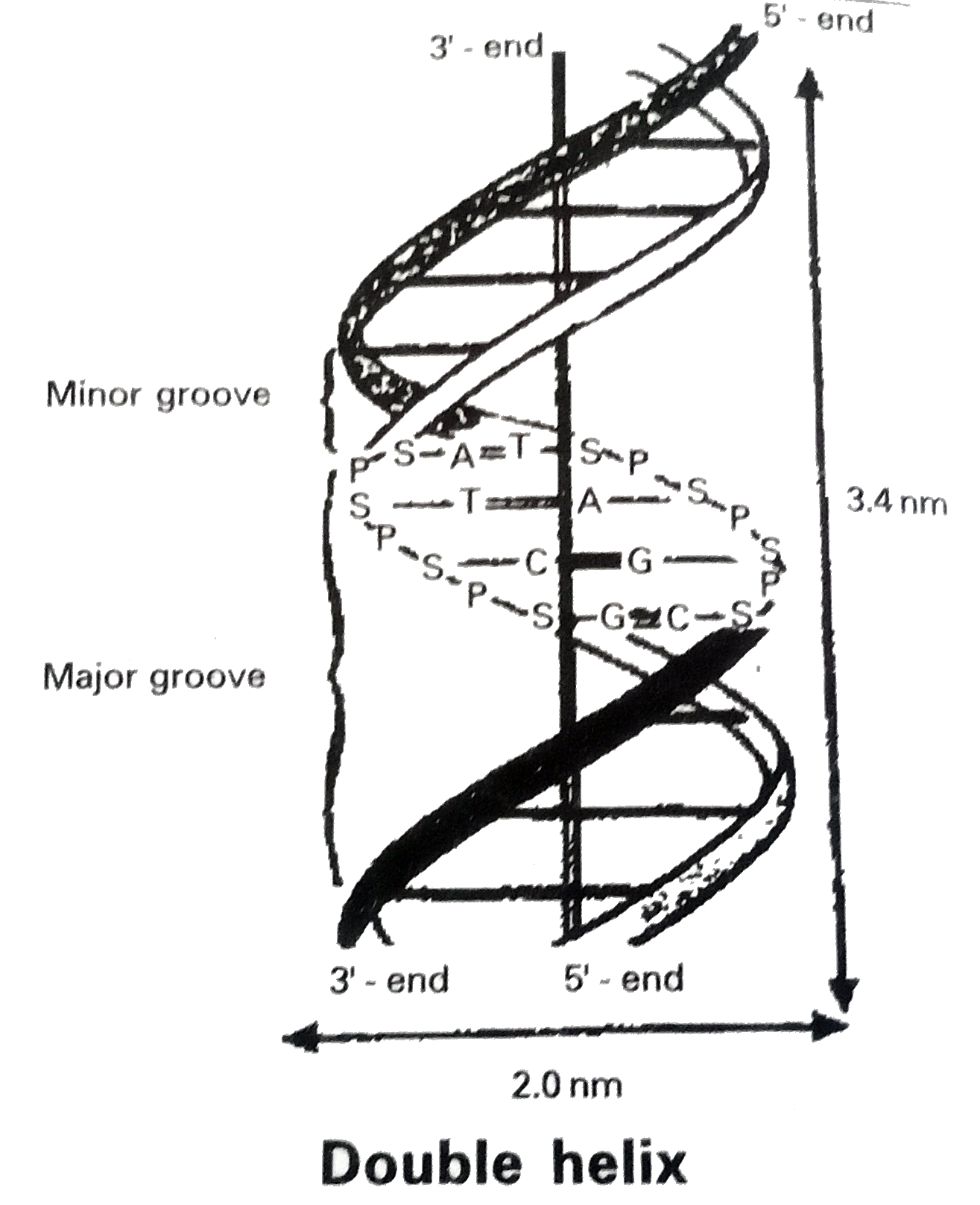Explain the structures of DNA and RNA. Solution in Telugu
Structure of DNA : To understand the structure of DNA , we should known the charagaff's rule , which states that :
1. Base composition on DNA for a particular organism is constant throughout all the somatic cells
2. Base composition always varies from one organism to another and is expressed by the dissymmetry ratio , A+TG+C
3. Organisms closely related to ech other often have similar base composition and hence have closed values for their dissymmetry ratio.
4. In a given organism the amount of adenine is always equal to the amount of thymine (A=T) and amount of guanine is equal to amount of cytosine (G=C).
5. In a given organism the total amount of purine bases are always equal to total number of pyrimidine bases (i.e.,) (A+G=T+C).
M. wilkins found that within the crystal there is a repeat distance of 3.4 nm and there are ten subunits per turn.
watson - Crick model for DNA : From the above observations watson and crick constructed a model for DNA. This model consists of two right handed polynucleotide chains that are complimentary and coiled about the same axis to form double - helix . Some specific base pairs can be spatially accommodated and these are A-T and G-C pairs. The bases are closely associated with each other by hydrogen bonding. The helix has diameter of about 2.0 nm and contains 10 nucleotide pairs in each turn of helix as shown above:

Structure of RNA : The native RNA is single stranded rather than a double stranded helical structure characteristics of DNA. However , given the complementary base sequence with opposite polarity , the single of RNA may fold back on itself like a hairpin and thus acquire double stranded pattern. In the region of hairpin loops, "A" pairs with U and G pairs with C.The base pairing in RNA hairpins is frequency imperfect. The proportion of helical regions in various type of RNA varies over a wide range .

Topper's Solved these Questions
- BIOMOLECULES BOOK - VIKRAM PUBLICATION ( ANDHRA PUBLICATION)CHAPTER - BIOMOLECULES EXERCISE - INTEX QUESTIONS
7 Videos
- BIOMOLECULES BOOK - VIKRAM PUBLICATION ( ANDHRA PUBLICATION)CHAPTER - BIOMOLECULES EXERCISE - DAM SURE VSAQ
18 Videos
- BIOMOLECULES BOOK - VIKRAM PUBLICATION ( ANDHRA PUBLICATION)CHAPTER - BIOMOLECULES EXERCISE - DAM SURE SAQ
10 Videos
- ANDHRA PRADESH MARCH-2019BOOK - VIKRAM PUBLICATION ( ANDHRA PUBLICATION)CHAPTER - ANDHRA PRADESH MARCH-2019EXERCISE - SECTION-C
5 Videos
- CHEMISTRY IN EVERYDAY LIFEBOOK - VIKRAM PUBLICATION ( ANDHRA PUBLICATION)CHAPTER - CHEMISTRY IN EVERYDAY LIFEEXERCISE - Intex questions
5 Videos
Similar Questions
Glucose or sucrose are soluble in water but cyclohexane and benzene (simple six membered ring compound are insoluble in water. Explain.
View SolutionDefine carbohydrates.
View SolutionExplain the denaturation of proteins.
View SolutionHow is ozone prepared from oxygen ? Explain its reaction
i) C2H4 ii) KI ii) Hg iv) PbS
View SolutionSleeping pills are recommended by doctors to the patients suffering from sleeplessness but is not advisable to take its doses without consultation with the doctor.Why?
Consider the effect of tranquilizers or antidepressants on the nervous system.
View SolutionSynthesis of DNA from RNA is explained by
View SolutionDescribe the structure of DNA or RNA .
View Solutionजेम्स वाटसन एवं फ्रांसिस क्रीक द्वारा प्रतिपादित DNA मॉडल की संरचना का वर्णन कीजिये। DNA तथा RNA में अंतर स्पष्ट कीजिये।
View Solutionडी.एन.ए तथा आर.एन.ए में अंतर स्पष्ट कीजिये।
View Solutionडी०एन०ए० की संरचना का वर्णन कीजिए तथा आर०एन०ए० से अन्तर स्पष्ट कीजिए।
View SolutionSketch and explain the structure of DNA and various type of RNA.
View SolutionSketch and explain the structure of DNA and various types of RNA.
View SolutionDNA व RNA में अंतर स्पष्ट कीजिए |
View SolutionTypes Of DNA and RNA and Nucleosome Structure
View SolutionRNA के माध्यम से DNA संश्लेषण को निम्न द्वारा समझाया गया-
View Solution
